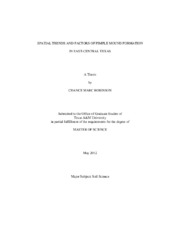Spatial Trends and Factors of Pimple Mound Formation in East-Central Texas
Abstract
Pimple mounds are circular to elliptical domes with basal diameters ranging from 3 to more than 30 m, and heights of 30 cm to more than 2 m above intermound levels. For almost two centuries, the origin of these features has been speculated upon by scientists without general consensus as to one of over 30 different mechanisms suggested for their origin. These soil microfeatures can be observed throughout portions of East Texas as well as Louisiana, Arkansas, Oklahoma, and Missouri. Pimple mounds have been extensively mapped throughout East Texas as complexes covering over 1.0 million ha in 47 soil survey areas. About 600,000 ha are on Pleistocene-age geological formations.
This study focused on 5,500 ha in Leon County, Texas, mapped as Rader-Derly complex and Derly-Rader complex. Rader (Aquic Paleustalfs) is on mounds and Derly (Typic Glossaqualfs) in the low intermounds. These soils are mapped primarily on terraces of the Trinity River system within the survey area. Using elevation levels published for the various fluviatile terrace deposits of the Trinity River, six groups (five terrace level groups and an upland group) were identified for analysis of mounds within the study area. Processes and factors of soil formation during the life of these features were considered using two methods ? remotely sensed elevation data and sampling data collected in the field. Size, shape, and relief of mounds were analyzed using airborne-based, remotely sensed LiDAR (Light Detection and Ranging) elevation data. Particle size distributions and pedon descriptions of mounds formed on materials of various ages were compared across the study area with special emphasis given to spatial trends.
Analyses indicate a fluvial origin with pimple mound orientation corresponding to surrounding ridge and swale features of the paleoriver. Pimple mounds within the study area formed in the presence of sandy to loamy alluvial sediments and require the presence of accretionary ridge microtopography over point bar deposits. This alluvial parent material and topography were further developed by fluctuations in climate and vegetation over time. The erosional influence of bioturbation by animals and the intense rainfall and flood events which frequent the study area provided an environment in which these soil microfeatures have developed and over time exhibit increased levels of pedogenesis.
Subject
pimple moundsmima mounds
spatial trends
fluvial origin
pedogenesis
LiDAR
Light Detection and Ranging
Leon County
Texas
Citation
Robinson, Chance (2012). Spatial Trends and Factors of Pimple Mound Formation in East-Central Texas. Master's thesis, Texas A&M University. Available electronically from https : / /hdl .handle .net /1969 .1 /ETD -TAMU -2012 -05 -10997.


